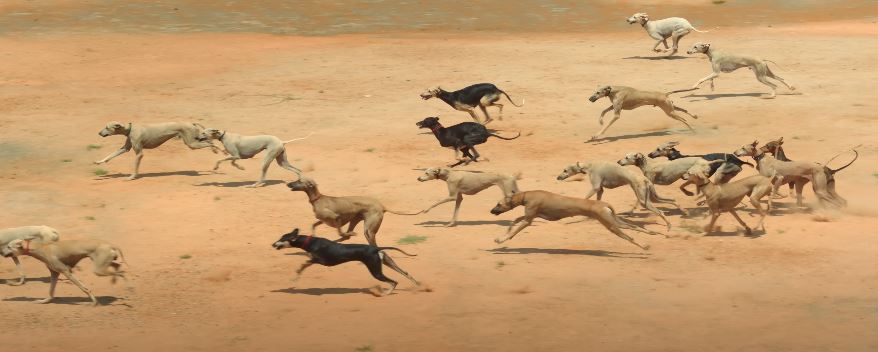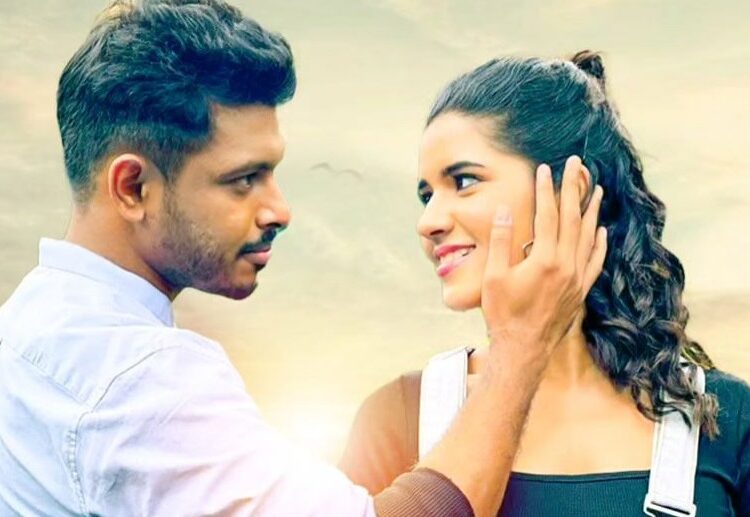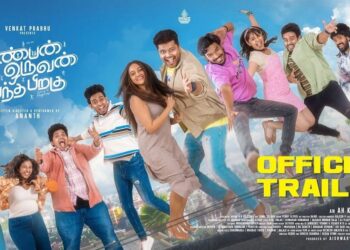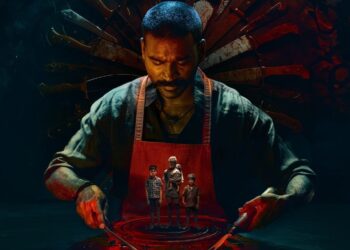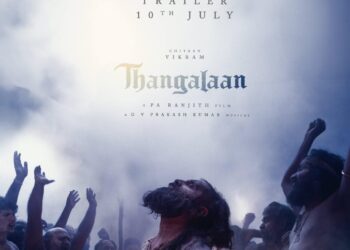Though the song I sing is the same,
I shall continue to sing it through my lifetime.
I shall rip my guts from my stomach,
and transform it into a lute,
making its strings echo through each street.
I will always seek the ears who yearn to hear the truth.– Telugu Poet Nangamuni.
Land and Generations
Vadivelu’s heavy voice recites this eerie poem against a wide shot of the land of Salem. It acts both as an introduction to the film’s characters and the film’s director himself, Mari Selvaraj, who had previously directed the critically acclaimed Karnan and Pariyerum Perumal. The poem is haunting, morbid, and defiant. Vadivelu’s articulation gives the pain-filled poem a soul. It constructs the feel of the film as something that cannot be ignored. It is both the character of Maamannan and the director, Mari, declaring that he will continue to create his art, to reap his body before the earth, to lay the seething sorrow of caste before all, for there will be someone out here in this cruel world who will come to listen to these histories.
This forceful and gruesome poem is presented against the backdrop of Vadivelu and Udhayanidhi Stalin on a mountain top, watching over the overpowering landscape. The shot is spectacular in capturing the finite body of man before the earth. It reveals just how frail human life is, compared to the world around it. But there is also a sense of confrontation—that no matter how vast or infinite the struggle of living is, one must continue to liberate oneself from enslavement. The subtextual generational conversation between Vadivelu and Udhayanidhi Stalin is also symbolised here. The fact that the struggle will continue from one generation to the next, contains echoes of the Chinese folktale, The Foolish Old Man Who Removed the Mountains, a tale that was weaponized by Chairman Mao Zedong to urge the masses in China to fight against US imperialist and Chinese feudal lords.
“When I die, my sons will carry on; when they die, there will be my grandsons, and then their sons and grandsons, and so on to infinity. As high as they are, the mountains cannot grow any higher, and with every bit we dig, they will be that much lower. Why can’t we clear them away?”
The Dialectical Nature of The Hunting Dog
The sight of hunting dogs running after something quickens the pace of the trailer, an urgency mounts against the visuals. They are chasing something. Hunting something. Waiting to ravage something. Or someone. The shots of the running dogs, interjected with images of people getting brutalised, wounds a texture of anxiety through the screen. The stakes are high. The memories of Karuppi from Pariyerum Perumal return. An antithesis emerges between Karuppi and these hunting dogs. Mari often uses these animals as metaphors to explain the dialectical nature of caste society. In the real world, hunting dogs are sometimes used to abuse and violate Dalits, while at the same time, a Dalit in possession of a hunting dog is punished for it because it is an act that subverts the power structure. Karuppi in Pariyerum Perumal was killed because a Dalit boy should not be in possession of such a powerful creature.
In Pariyerum Perumal, the image of Pariyan, a scared Dalit boy running after Karuppi, who is about to be killed by a moving train, completely collapses in this scene, where the hunting dogs are instead alluded to as running after a scared Dalit boy (assumed to be a young Vadivelu). This inverse of imagery presents a discourse on the dialectical state of power and authority. The hunting dog is a weapon that can be possessed by the oppressor and the oppressed. Its meaning is related to the matter that possesses it. It is through that interaction between matter and thought that the philosophical nature of its significance emerges. This dialectical perspective is brilliantly brought out by the semiotics of the hunting dog.
The Politics of Caste
Mari Selvaraj is not a director who cowers away from cinematically capturing the political landscape of Tamil Nadu. He had very briefly alluded to the Manjolai Massacre, the gruesome murder that took place in the Thamaribarani River, where 16 Dalit Plantation workers were murdered under Karunannidhi’s government. It is very likely that there would be a political rivalry between the characters of Vadivelu and Fahadh Fasil, not just an ideological one but an electoral one. It is not an unknown fact that caste is foundational to the political system of Tamil Nadu, as it is in the rest of India. The imagery of political posters perfectly captures how visual mediums are used to express political power and caste dominance. It can be understood that Fahadh’s political party is represented by the colours Black and Yellow, while Vadivelu’s party is represented by the colours Black and Grey. Colours hold immense ideological meaning in the Tamil political landscape. So it will be very interesting to see what contradictions unfold between the two rivals and how much of the cinematic interpretation can stay true to the material conditions of Tamil Nadu Politics.
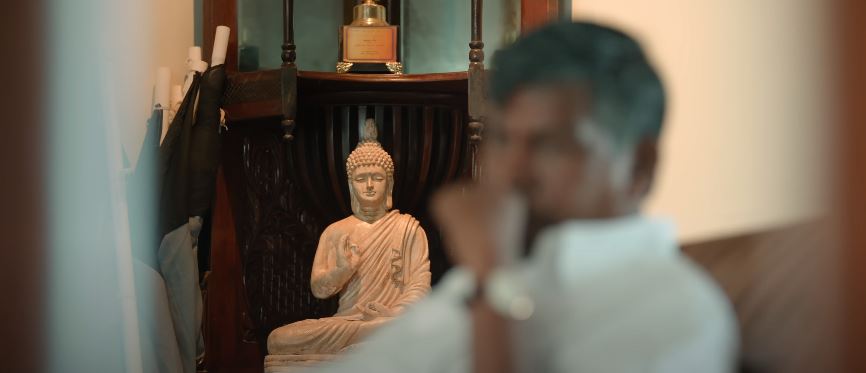
Political Theology and Emancipation
In order to escape the enslavement of caste, the Dalits of Tamil Nadu, just as the Dalits of the rest of the subcontinent, weaponized conversion as a way to emancipate themselves from caste oppression. The emergence of Christianity and Islam as theologically prominent religions in the Indian Subcontinent was catalysed by the anti-caste liberation movements. Among the oppressed castes, there have been many politically theological movements that have occurred across centuries.
This particular shot features an amalgamation between man, politics (represented by Vadivelu and Maamannan’s political party’s black and grey flag), and religion. The scene expresses the interconnected locusts of ideas that form behind the action of Man. The focal point of the scene being the Buddha and the political flags, while the character of Maamannan himself is blurred, alludes to the fact that theology and political ideology often intersect, subsuming the individual, whether they be the oppressed or the oppressor.
The Buddha in the background here expresses one such religious political movement that can be traced back to both Ambedkar and Iyothee Thaas Pandithar. Tamil Nadu has a long and proud history of Revolutionaries who have fought against oppressive structures. One such icon that belongs to that history is Pandithar Iyothee Thass. He had been one of the most pioneering and prominent voices for conversion to Buddhism as a way of emancipating oneself from the misery of caste society. The Tamil intellectual has theorised that the Dalits of the Tamil Lands were indigenous Buddhists who needed to reclaim their religious identity away from the oppressor castes. He as well as Dr. Ambedkar, a successor of Iyothee Thassar’s time, both utilised political theology as a form of liberation for the Dalit masses. In contemporary times, Ambedkarites, those who abide by the political, philosophical, and ideological thinking of Ambedkar, see the sect of Nayavana as a way of emancipating themselves from caste enslavement, but some have criticised the legitimacy of this political maneuver as just another reformist method by which to pacify the Dalit masses.
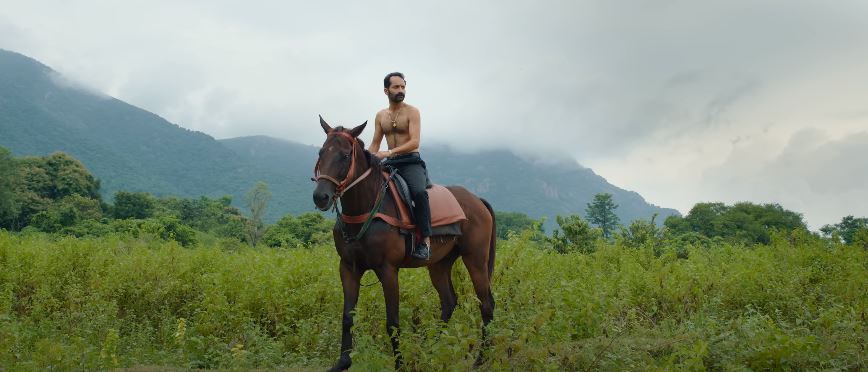
Of Constraint and Attention
While Tamil cinema has a long history of visualising caste society, it has always been done to protect the caste-feudal, capitalist structure of Tamil Nadu. It has never been visualised in a way that is critical of the aesthetic itself. This particular shot of Fahad Fasil acts almost as an inverse of the shot from Karnan, where Karnan was riding a horse. There is a sense of stagnation and control in this imagery. The horse in this image is domesticated, controlled, and chained. It shows the caste oppressor’s authority over other living creatures. It is a direct contrast to Karnan, where the horse is not subjugated by power but lives as the adopted pet of a young boy. The sleek saddle and straps reveal the wealth with which Fahadh Fasil is bestowed. A saddled horse is also more comfortable to ride. The allegory of how nature is subsumed and enslaved into violent and unjust power for the luxury of reactionaries is perfectly captured by the image of the saddle. Here we can see Fahadh dominating the screen, the landscape, and the entire ecosystem. He demands the attention of the viewer. Attention is a critical element that is utilised by the oppressor to impose itself upon a people. Attention to narrative, attention to history, and attention to pain. These attentions are manipulated by those in power to maintain their structural advantage. The masses must see beyond what is given; they must read the subtleties and truth embedded deep within the anatomy of a scene to comprehend the power structure of caste society.
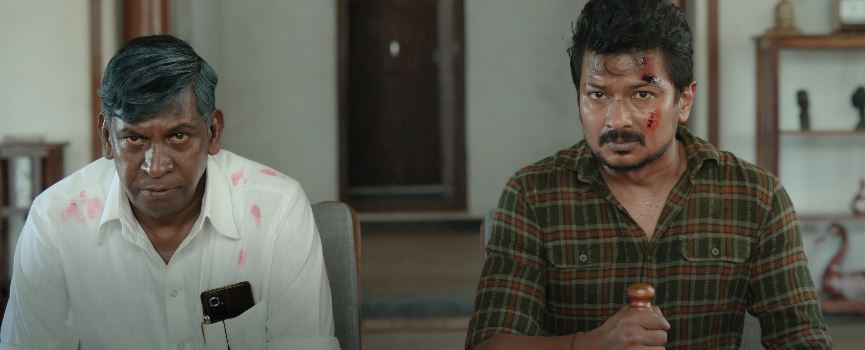
Reclaiming Self-Respect Through a Name
As the screen fades to black, a voice in the background shouts “Dei Maamanna”. These two words, when we deeply analyse them, voice the disparity between self-perception and the hegemony of the caste system. The character of Vadivelu is said to be a redux of Esaki from the 1992 film Thevar Magan. Mari had said that the film was foundational for his creation of Maamannan. It is from the wounds of Thevar Magan, a film that glorifies caste-feudalism, that Maamannan arises. The demoralised character of Esaki, who is a humble and devoted servant to the Thevars, becomes a dignified man of his own right in this film. This retelling presents the subversion of power; Esaki is now a Maamannan. Although he gives himself an esteemed title, the casteist world around him does not accept it. They dishonour and degrade it. The dei is meant to undermine the power of Esaki. It was meant to degrade him and deteriorate the image of self-respect he has created for himself. There is an immense amount of negation between the words “dei” and “Maamanna”. It recalls the scene from Karnan where the abusive police officer says, Nethu ninga pera mathingana inniki ninga raajava da?
Man and Creature as One
Within the Tamil cultural context, pigs don’t receive any form of dignity. Unlike cows, which are associated with divinity, pigs are often associated with sloth and filth. Mari Selvaraj interestingly brings attention to this dichotomy of how caste society affects not only people and land but the creatures that live amongst them as well. By having one of the main protagonists hold on to the little piglet in an endearing manner, the author allegorizes the vulnerability of souls that have been debased and violated by caste violence. It emphasises the urgency of defending those who are powerless. The shot reverberates the truth that the innocent, defenceless, and vulnerable need to be protected from violence. This also speaks of the parallelism between Udhayanidhi Stalin and the piglet itself; just as in Pariyerum Perumal, both Pariyan and Karuppi were signified as being one of the same, this shot connotes the vulnerability of both man and animal and the need for one to arm itself, to weaponize its anger, for the survival of its bloodline.
The trailer has embedded in itself many crucial and critical symbolisms, metaphors, allegories, and negations. Mari Selvaraj has truly demonstrated his cultural intellect with just a trailer. With each of his films, his instrumentalization of the visual medium immensely improves, reaping the structure of Tamil cinema from its spine and constructing a new subversive narrative. Both the technology of film and the politics of stories are deconstructing the old architecture of Tamil cinema while simultaneously birthing something new. Mari Selvaraj’s films are trying to bring out the intellectual in the masses. Urging them to analyse their environment and deeply interpret the power structures that exist in their worlds, because just as in his films, in real life, power and liberation are expressed through semiotics. Land, language, animals, clothing, landscapes, and histories all bear meanings beyond themselves. They all bear the symbol of power, and to question that structure of authority, and organise an insurrection against the existing tyranny of caste, one must first know how to perceive it. And for the act of perspective to flourish among the new generation, Mari’s films are an exemplary starting point. Let us hope the film lives up to the expectations it has placed on itself.
Follow us on Instagram, Facebook or Telegram for more updates and breaking news.




